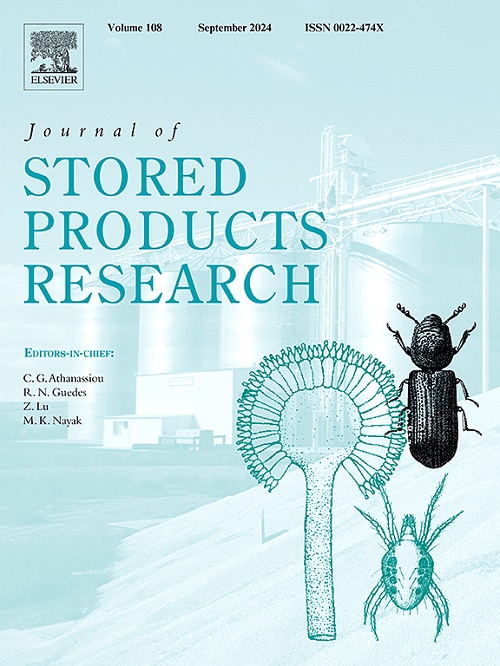储粮中谷物象虫的可持续管理方法
IF 2.7
2区 农林科学
Q1 ENTOMOLOGY
引用次数: 0
摘要
谷物象甲(鞘翅目:干象甲科),俗称小麦象鼻虫,是一种粮食害虫,对储粮业构成严重威胁,造成重大经济损失和粮食不安全。本文介绍了不同的害虫防治策略,重点介绍了化学和生物防治策略。化学控制,包括熏蒸剂如磷化氢和杀虫剂如拟除虫菊酯,提供了快速有效的解决方案。耐药性、环境污染和健康风险的出现突出表明需要采取替代战略。利用天敌(如拟寄生虫、昆虫病原真菌和微生物剂)的生物管理策略提供了可持续和环保的解决方案。两种生物制剂,捕食者黑僵菌(Teretrius nigrescens)和寄生真菌白僵菌(Beauveria bassiana),降低了象鼻虫的密度,降低了生态足迹。病虫害综合治理旨在将这些工具与预防和监测结合起来,形成全面、长期的防治规划。在这些新方法中,RNA干扰技术和基因编辑直接针对象鼻虫基因。这减少了虫害,同时保护了非目标物种。此外,基于物联网的监测等精密技术提供了创新的非化学解决方案。这篇文章强调了各种农药的经济影响,从负担得起的惰性粉尘到先进的生物农药。传统技术和未来技术的结合将有助于改善可持续的小麦象鼻虫管理战略,从而减少环境足迹,同时又不会对粮食质量产生任何有害影响。本文重点介绍了小麦黑穗病的生物学和防治,特别是全球农业和储存系统的可扩展和实用方法。在大胆出击的过程中,它提醒了所有的寄生虫,研究、创新和合作每次都会战胜它们。本文章由计算机程序翻译,如有差异,请以英文原文为准。

Sustainable approaches for managing Sitophilus granarius in stored grains
Sitophilus granarius (Coleoptera: Dryophthoridae), commonly known as the wheat weevil, is a grain pest that poses a severe threat to the storage industry, causing significant economic loss and food insecurity. This review introduces different pest management strategies, with a focus on chemical and biological control strategies. Chemical control, including fumigants like phosphine and insecticides like pyrethroids, offers quick and effective solutions. The emergence of resistance, environmental contamination, and health risks highlights the need for alternative strategies. Biological management tactics that use natural enemies like parasitoids, entomopathogenic fungi, and microbial agents provide sustainable and eco-friendly solutions. Two biological agents, the predator Teretrius nigrescens and the parasitic fungus Beauveria bassiana, compromise weevil density with low ecological footprints. Integrated pest management works towards integrating these tools with prevention and monitoring into full, long-term control programs. Among these novel approaches, RNA interference technology and gene editing directly target weevil genes. This reduces infestations while safeguarding species that are non-target. Furthermore, precision technologies like the Internet of Things-based monitoring provide innovative, non-chemical solutions. This article highlights the economic implications of various pesticides, ranging from affordable inert dusts to advanced biopesticides. The integration of conventional and futuristic technology will help improve sustainable wheat weevil management strategies, leading to a reduced environmental footprint without any detrimental impact on grain quality. This article focuses on the biology and control of S. granarius, particularly on scalable and practical approaches for global agricultural and storage systems. In striking out boldly, it makes a point of reminding all the parasites out there that research, innovation, and collaboration will trump them every time.
求助全文
通过发布文献求助,成功后即可免费获取论文全文。
去求助
来源期刊
CiteScore
5.70
自引率
18.50%
发文量
112
审稿时长
45 days
期刊介绍:
The Journal of Stored Products Research provides an international medium for the publication of both reviews and original results from laboratory and field studies on the preservation and safety of stored products, notably food stocks, covering storage-related problems from the producer through the supply chain to the consumer. Stored products are characterised by having relatively low moisture content and include raw and semi-processed foods, animal feedstuffs, and a range of other durable items, including materials such as clothing or museum artefacts.

 求助内容:
求助内容: 应助结果提醒方式:
应助结果提醒方式:


